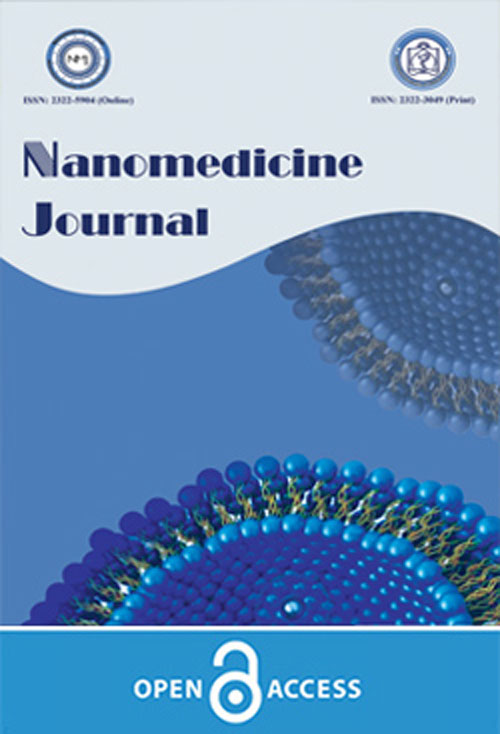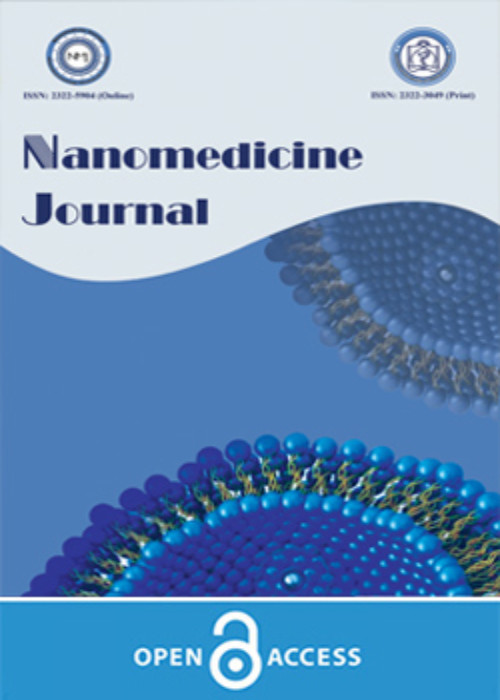فهرست مطالب

Nanomedicine Journal
Volume:7 Issue: 4, Autumn 2020
- تاریخ انتشار: 1399/07/06
- تعداد عناوین: 9
-
-
Pages 251-262
Nanoparticles are of highlighted interest in scientific research for a wide range of applications as they bridge the gap between atomic structures and bulk materials with unique physicochemical properties. This systematic review was aimed to study the current trends in biological mediated cancer research using biogenic silver nanoparticles (AgNPs) against hepatic cancer cell lines. For this purpose, the electronic databases including Cochrane Library, PubMed, Scopus, Science Direct, ProQuest, Embase, and Web of Science were searched. Forty-six studies passed the eligibility assessments and entered into the current study. All of the studies stated the size distribution of biosynthesized AgNPs below 100 nm with different shapes. Whereas, most studies stated spherical morphology for biogenic AgNPs. Most of the studies (91.30%) represented significant anticancer activity of biogenic AgNPs toward hepatic cancer cell lines. The molecular mechanisms also showed the induction of intracellular Reactive Oxygen Species (ROS) and apoptosis through the biogenic AgNPs-treated hepatic cancer cells. The AgNPs-mediated induction of intracellular ROS overgeneration and ATP synthesis interruption disturb the mitochondria respiratory chain function resulting in the induction of mitochondrial pathway apoptosis. Overall, this systematic review provided strong preliminary evidence representing the efficacy of biogenic AgNPs to combat hepatic cancer cells through in vitro models.
Keywords: Anticancer activity, Hepatic Cancer, Nanotoxicity, Silver nanoparticles -
Pages 263-271
The usage of clinical devices in the cardiovascular treatment, hemodialyze system and other biomedical applications has improved recently. Direct contacts of biomaterials like poly(lactic acid) biopolymer with blood result in the activating of platelets, white blood cells , coagulation structure and complement cascades. Poly(lactic acid) is a sustainable, renewable, compostable, biobased, biodegradable, bioabsorbable , biocompatible polymer. This polymer has many applications in the synthesis of blood contacting mats like nanofibrous vascular scaffolds and hemodialyze nanosheets.Mechanical interruption of the blood vessel wall throughout grafting of cardiovascular devices starts local hemostatic replies. Improving the safety of the blood contacting nanostructure grafts is a main necessity. The controlling of the interactions of proteins and platelets to the surface of a blood contacting biomaterial is a significant factor. So, the assessments of these material’s influences on blood are necessary.This article references more than 80 articles published in the last decade and reviews the latest hemocompatibility assays of poly(lactic acid) nanostructures used in the blood contacting field.
Keywords: Biomedical, Hemolysis, Hemocompatibility, Nanostructures, Poly (lactic acid) -
Pages 272-283Objective(s)
This study was aimed to investigate the synthesis of novel zinc oxide (ZnO) nanoparticles (NPs) using Solanum trilobatum leaf extract as the reducing and capping agents, called green synthesized zinc oxide nanoparticles (GS-ZnONPs).
Materials and MethodsChemically synthesized zinc oxide nanoparticles (CS-ZnONPs) were synthesized using precipitation method with zinc nitrates hexahydrate as reducing precursors. The synthesized GS- and CS-ZnONPs were examined and characterized using UV-visible spectroscopy, Transmission Electron Microscopy (TEM), Scanning Electron microscopy (SEM), Energy dispersive X-ray analysis (EDAX), and X-ray diffraction (XRD) analysis, respectively.
ResultsGS-ZnONPs exhibited a higher zone of inhibition of 28.6 mm, 27.63 mm, and 29.33 mm for Bacillus subtilis, Escherichia coli, and Klebsiella pneumoniae, respectively compared to CS-ZnONPs. From the growth inhibition experiments with E. coli and Staphylococcus aureus, it was evident that GS-ZnONPs have exhibited higher growth inhibition as compared to CS-ZnONPs. The IC50 for CS-ZnONPs in MCF-7 cell line was found at 136.16 µg/mL and for GS-ZnONPs was found at 85.05 µg/mL. The proliferation of cancer cells were directly proportional to the concentration of NPs. As compared to CS-ZnONPs, GS-ZnONPs have exhibited higher cytotoxic effects on MCF-7 cell line.
ConclusionIt was concluded that GS-ZnONPs represented much enhanced anticancer and antibacterial activity compared to CS-ZnONPs.
Keywords: Antimicrobial, Breast Cancer, Cytotoxicity, Zinc oxide nanoparticles -
Pages 284-290Objective(s)
Toxico-histopathological studies are used to assess the toxic impacts of nanoparticles in organism exposure. The present study aimed to evaluate the prospective nano-cytotoxicity impacts of Gd(III)-anionic linear globular dendrimer second-generation G2-C595 (Gd[III] dendrimer G2-C595) contrast nanoprobe in terms of the exposure of many nude mice organs and organisms. In addition, we assessed the potential of the Gd(III)-dendrimer G2-C595 nanoprobe as a novel magnetic resonance imaging (MRI) nano-contrast agent for the human breast cancer cell line (MCF-7) and human embryonic kidney cell line (HEK-293).
Materials and MethodsGadolinium (Gd[III]) was loaded with dendrimer G2 and conjugated with the C595 monoclonal antibody to generate the Gd(III)-dendrimer G2-C595 to determine the impact on MUC1 beneficial cancer tumors. The cytotoxic effects of the Gd(III)-dendrimer G2-C595 nanoprobe on the HEK-293 cells were also investigated in-vitro and in-vivo. In addition, the Gd(III)-dendrimer G2-C595 nanoprobe was used on nude mice bearing the MCF-7 tumors to explore its specific activity against the in-vivo model of cancer.
ResultsThe Gd(III)-dendrimer G2-C595 contrast nanoprobes affected the cytotoxicity of MCF-7, and no in-vivo toxicity was induced in the HEK-293 cells, kidneys, heart, lungs, brain, liver tissues, and other organs.
ConclusionAccording to the results, the Gd(III)-dendrimer G2 and Gd(III)-dendrimer G2-C595 induced no toxicity in the HEK-293 cells and heart, liver, and brain tissues of mice. In addition, the Gd(III)-dendrimer G2-C595 showed specific anti-action against the in-vivo tumor model. Therefore, the Gd(III)-dendrimer G2-C595 nanoprobe is highly recommended as a novel and effective MR contrast agent and antitumor carrier agent. Furthermore, the Gd(III)-dendrimer G2-C595 nano-sized probes demonstrated excellent biocompatibility and safety with no impact on normal organ functioning.
Keywords: Gd(III)-Dendrimer G2-C595 Nanoprobe, Human Embryonic Kidney Cells (HEK-293), human breast cancer cell line (MCF-7), Nanoparticle Toxicity -
Pages 291-298Objective(s)Bioactive compounds like curcumin can be incorporated into food packaging formulation either to enhance physico-mechanical properties or to improve the biological activity of the packaging systems. Furthermore, it enables the packaging to monitor the changes in food quality.Materials and MethodsIn the present study, the effect of curcumin concentration (0.2, 0.4 and 0.6%) on physico-mechanical and biological activity of soluble soy bean polysaccharide (SSPS)/TiO2 nanoparticles nanocomposites were investigated. Additionally, the release behavior of this bioactive compound from the developed film was tested. Finally, the color changing of SSPS/TiO2 nanoparticles/curcumin nanocomposites in contact with different mediums were examined.ResultsWhen the curcumin concentration increased up to a certain point (0.4 %), the physical and mechanical properties of the film improved, but beyond this point, an opposite effect was observed. SSPS/TiO2 nanocomposite showed strong antibacterial activity against both gram positive and negative bacteria. Small amount of curcumin released in ethanol as a food simulant.ConclusionThe films incorporated by curcumin can be used as promising packaging systems for non-destructively detecting quality and freshness of foods.Keywords: Curcumin, Nanocomposite, SSPS, TiO2 nanoparticles
-
Pages 299-307Objective(s)
In cirrhotic cardiomyopathy, a rise in pro-inflammatory cytokines results in the up-regulation of inducible nitric oxide synthase (iNOS), and the overproductions of nitric oxide (NO) and cyclic guanosine 3’, 5’ monophosphate (cGMP). Berberine (BBR), an isoquinoline-derived alkaloid isolated from Rhizoma coptidis, possesses anti-inflammatory, anti-oxidative, and cardioprotective properties. In this study, the effect of BBR-loaded micelles in a rat model of cirrhotic cardiomyopathy resulted from bile duct-ligation (BDL) was examined. Further, a possible role for NO-cGMP signaling was clarified.
Materials and MethodsCirrhotic rats were orally treated with BBR-loaded micelles (50 mg/kg), free BBR (50 and 100 mg/kg) and silymarin (100 mg/kg). A selective iNOS inhibitor, aminoguanidine (AG) 100 mg/kg, i.p., was administered. iNOS expression and nitrite concentration were calculated using immunohistochemistry (IHC) and Griess reagent methods, respectively. Besides, ventricular tumor necrosis factor-alpha (TNF-α), cGMP, and serum interleukin -1beta (IL-1β) were measured using ELISA kits.
ResultsTNF-α and IL-1β, nitrite, cGMP, and the expression of iNOS increased significantly in BDL rats. However, BBR (100 mg/kg), nanoBBR (50 mg/kg), and silymarin markedly lowered the levels of these markers. Notably, AG increased the nanoBBR effect.
ConclusionThis cardioprotective effect of nanoBBR probably mediated at least in part by down-regulations of the NO-cGMP pathway, and the inflammatory mediators.
Keywords: Bile duct-ligation, Cardiomyopathy, Nanoberberine, Rat, The NO- cGMP pathway -
Pages 308-314Objective(s)Firefly luciferase is a monooxygenase enzyme that emits flash of light during the enzymatic reaction. Luciferase has been used in many bioanalytical fields from ATP detection methods to in vivo imaging. In recent decades, focus has been carried out on nanoparticles for their fluorescence properties. Semiconductor quantum dots have unique tunable properties that turn them promising tools in biological and biomedical researches, as nanosensors, photo-electrochemical and light-emitting devices. Carbon-based nanoparticles such as graphene quantum dots (GQDs) have useful benefits such as low toxicity, suitable luminescence and easy preparation.Materials and MethodsIn this study, recombinant P. pyralis luciferase was expressed and purified based on N-terminal His-tag and then kinetic parameters of enzyme activity such as Km and Vmax values in presence and absence of GQDs were calculated.ResultsThe results showed that Km for ATP and luciferin substrates in the presence of GQDs were increased. Fluorescence spectroscopy showed significant changes in protein structure or in fluorescence spectra and decrease in the activity of the luciferase in presence of GQD. Both loss of activity and increase of substrates Km showed decrease of catalytic efficiency presumably through structural alteration.ConclusionFrom these data it can be concluded that the protein structure under the influence of GQD may have changed that lead to alteration of enzyme activity.Keywords: Bioluminescence, Graphene, Luciferase, Quantum dot
-
Pages 315-323Objective(s)This study deals with mycosynthesis and characterization of selenium nanoparticles (SeNPs) using the Penicillium chrysogenum PTCC 5031 and evaluating their antibacterial activity.Materials and MethodsThe formation of SeNPs was confirmed with the color change from pale yellow to orange. Tyndall effect also confirmed the formation of colloidal systems through the samples. The SeNPs were characterized using different analytical techniques including photon correlation spectroscopy (PCS), Scanning Electron Microscope (SEM), Atomic Force Microscope (AFM), Energy Dispersive X-ray (EDX), X-ray diffraction (XRD) and Fourier Transform Infrared (FT-IR) analysis.ResultsOur findings revealed that SeNPs were fairly uniformed with good monodispersity and the lesser aggregation of particles in pH value of 7 with the average hydrodynamic size of 24.65 nm, polydispersity index (PdI) of 0.392 and zeta potential of -34 mV. The SeNPs revealed antibacterial activity against gram positive bacteria including Staphylococcus aureus, and Listeria monocytogenes with the zone of inhibition (ZOI) of 10 and 13 mm, respectively.ConclusionThe results of this study provided a potential solution to the growing need for the development of cost-effective and eco-friendly ways of nanoparticle synthesis to overcome the microbial resistance and control the infectious diseases. However, further investigations are required to demonstrate the efficacy of SeNPs through in vivo models.Keywords: Antibacterial activity, Biosynthesis, Nanobiotechnology, Selenium nanoparticles
-
Pages 324-334Objective(s)The present study aimed to design new nanoparticle-based shielding materials for photons used in single-photon emission computed tomography and positron emission tomography facilities.Materials and MethodsInitially, the mass attenuation coefficients and half value layer (HVL) of the composites were comprehensively investigated based on a silicon rubber containing various ratios of micro- and nano-barium sulfate (BaSO4), lead oxide (PbO), and tungsten oxide (WO3) particles at 60, 80, 100, 150, 200, 300, 400, 500, and 600 keV photon energies using the MCNP-X6 Monte Carlo (MC) code and WinXCOM software. In the second stage, the composites composed of 10 wt% and 20 wt% WO3 and PbO particles were constructed in a liquid silicone rubber-based matrix. The mass attenuation coefficients and HVL of the designed shields were experimentally assessed using Cs-137 and Am-241 radioactive sources.ResultsThe particles sizes of PbO and WO3 were within the range of 50-200 nanometers. The MC and measurement results indicated that the linear attenuation coefficients of the composites were augmented with the addition of all the studied nano- and micro-particles. However, the PbO composites had more significant shielding properties compared to the BaSO4 and WO3 composites.ConclusionAccording to the results, the nanocomposites had better ability to shield γ-rays at both energies compared to the micro-composites.Keywords: Nanocomposite, Nanoparticles, Nuclear Medicine, radiation shielding


